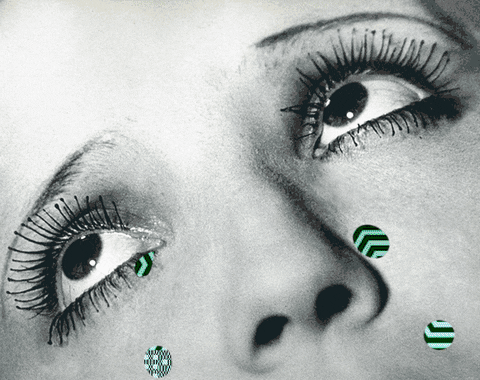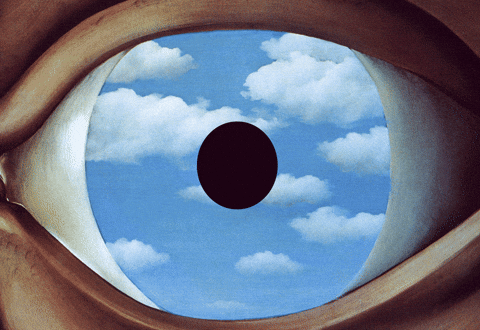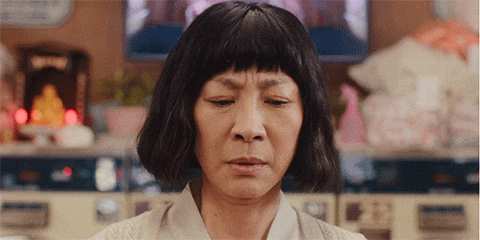Wide Awake and Dreaming
Larmes (Tears) by Man Ray
Image via GIPHY
Why are we still so obsessed with Surrealism? 👁️
When I think of Surrealism, I picture vast deserts, rippling waves, and windows that serve as portals to other worlds. The movement is synonymous with Salvador Dali’s melting clocks, René Magritte’s floating green apple, and Frida Kahlo’s iconic self-portraits. The term ‘surrealist’ was first used by French poet Guillaume Apollinaire in 1917, to describe something beyond reality. Yet it wasn’t until 1924 that the term gained widespread recognition, thanks to its introduction by André Breton in his Surrealist Manifesto.
Self-portrait on the Borderline between Mexico and the United States by Frida Kahlo (Image via Tumblr)
A century later, Surrealism remains just as relevant. Museums worldwide, from the Centre Pompidou in Paris to the Modern Art Museum of Fort Worth, are celebrating the movement's centennial with major exhibitions. On the auction block, René Magritte’s L’empire des lumières recently fetched $121.16 million at Christie’s, becoming the most expensive Surrealist artwork ever sold. Uncanny and dreamlike, the twentieth-century movement continues to hold our attention, seemingly growing in popularity and informing the work of many contemporary artists. So why does Surrealism still have us in such a chokehold?
The False Mirror by René Magritte (Image via GIPHY)
To answer this question, we have to revisit its origins. Surrealism emerged from the disillusionment of the post-World War I era, fuelled by the harsh realities of war and the dawn of new technologies. Today, as we navigate political turmoil, climate change, and the rapid advancement of AI, we find ourselves in a similarly unsettling time. This shared sense of unease and uncertainty may explain the enduring appeal of Surrealism and the growing demand for fresh, authentic forms of artistic expression.
Similarly, Surrealism was initially inspired by Dadaism, an anti-establishment movement known for its humorous and nihilistic philosophy. In the mid-2010s, we saw the rise of Neo-Dadaism and absurdist humour in the form of memes and digital content. Internet humour shifted towards the nonsensical, often focusing on loneliness and mental health. Perhaps this digital shift foreshadowed Surrealism's renewed appeal.
Pepe the Frog meme circa 2016
In recent years, we've witnessed a resurgence of Surrealism, especially among women artists who are reinterpreting the movement for a new generation. French artist Julie Curtiss embraces the uncanny and grotesque in her portraits of women, while Inka Essenhigh's dreamy motifs transport the viewer to new dimensions. Similarly, María Fragoso Jara’s red-infused canvases draw from the history of Mexican Surrealists and muralists. Women artists are breathing new life into Surrealism, reimagining its core themes and visual elements for a new era.
Bella Hadid in Schiaparelli at the 74th annual Cannes Film Festival (Image via Tumblr)
Additionally, the movement's influence extends beyond the canvas and into the world of fashion. In late September at Paris Fashion Week, Schiaparelli showcased an alluring new collection of couture under the warm glow of crystal chandeliers. The dimly lit Parisian basement set an eerie stage for the runway, where models embodied phoenixes, symbolising rebirth. The collection, which featured wings, spikes, and sheer veils, incorporated elements of Surrealism. The fashion house has a long-standing tradition of surrealist design, rooted in Elsa Schiaparelli's friendships with artists such as Salvador Dalí, Man Ray, and Meret Oppenheim, who were part of the vibrant Parisian art scene. Schiaparelli's legacy lives on in the avant-garde designs that we see today, from Doja Cat’s viral red crystallised couture to Bella Hadid’s trompe l’oeil lungs necklace, proving that Surrealism remains a powerful force in contemporary fashion.
Schiaparelli Fall 2024 Couture Collection (Image via Tumblr)
Schiaparelli Fall 2024 Couture Collection (Image via Tumblr)
Moreover, it seems we’re collectively drawn to the weird and wonderful, as surrealist aesthetics continue to appear everywhere within mainstream culture. The popularity of films such as Everything, Everywhere, All at Once, alongside the success of directors including Tim Burton, Stanley Kubrick, and Wes Anderson, who all explore the surreal, suggests an appetite for art that pushes the boundaries of reality. As film and television increasingly offer an escape from the daily grind of the 9-to-5, it's no surprise we're drawn to unique storytelling that captures the imagination.
Everything Everywhere All At Once (Image via GIPHY)
Surrealism remains an influential force in visual art, captivating us in film, fashion, and beyond. Tapping into our subconscious minds allows us to break free from conventional thinking and explore infinite possibilities. The question of our obsession with Surrealism alludes to something deeper than mere admiration for dreamlike visuals. Perhaps it resonates with us due to the uncertain times we live in. While it's unclear if Surrealism will still captivate us with the same intensity a century from now, one thing is true: our fascination with art that transcends reality shows no signs of waning.








